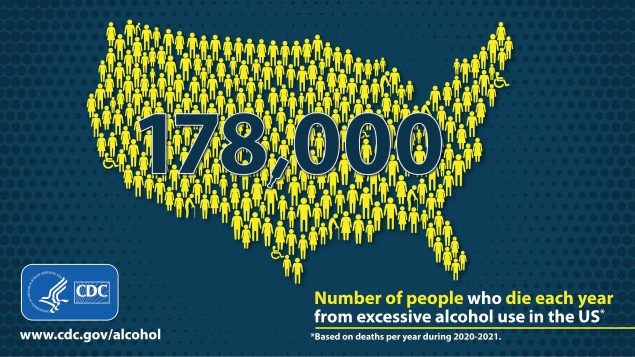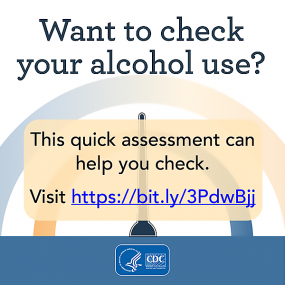Deaths from Excessive Alcohol Use in the United States
About 178,000 people die from excessive alcohol use in the U.S. each year. Learn how you can take action.

Excessive alcohol use was responsible for about 178,000 deaths in the United States each year during 2020–2021, or 488 deaths per day. This was a 29% increase from 2016–2017, when there were an estimated 138,000 deaths per year.1 These estimates are from the CDC’s Alcohol-Related Disease Impact (ARDI) application. The ARDI application shows estimates of alcohol-attributable deaths and years of potential life lost from 58 conditions by age, sex, and state.
Each year, deaths from excessive drinking:
- Shortened the lives of those who died by an average of 24 years, for a total of about 4 million years of potential life lost.
- Usually involved adults aged 35 or older and males.
These deaths result from conditions that develop from drinking over long periods of time, as well as from binge drinking – or drinking too much on one occasion.
- Two thirds of the deaths (about 117,000 deaths) are due to chronic conditions that develop from long-term alcohol use, including various types of cancer, heart disease, liver disease, and alcohol use disorder.
- One third of these deaths (about 61,000 deaths) happen from drinking too much on one occasion, such as from motor vehicle crashes, poisonings involving substances in addition to alcohol, and suicides.
Excessive drinking is a leading cause of preventable death in the United States, and it is also costly. It cost the nation $249 billion in 2010 (the most recent year of data available).
Everyone Can Help Prevent Excessive Alcohol Use
You can:
- Choose not to drink or to drink in moderation by limiting intake to 2 drinks or less in a day (if you’re a man) and 1 drink or less in a day (if you’re a woman), on days when alcohol is consumed. Some people should not drink any alcohol, including if they:
- Are pregnant or might be pregnant.
- Are younger than 21.
- Have certain medical conditions or are taking certain medicines that can interact with alcohol.
- Are recovering from an alcohol use disorder or are unable to control the amount they drink.
- Check your drinking, and learn more about the benefits of drinking less alcohol.
- Support effective community strategies to prevent excessive alcohol use, such as those recommended by the Community Preventive Services Task Force.
- Not serve or provide alcohol to anyone who should not be drinking, including people younger than 21 or those who have already consumed too much.
- Talk with your health care provider about your drinking behavior and request counseling if you drink too much.
States and communities can:
- Implement effective strategies for preventing excessive alcohol use to reduce the availability and accessibility of alcohol and increase its price, including regulating the number and concentration of alcohol outlets, limiting days and hours of alcohol sales, and avoiding further privatization of alcohol sales. Check out CDC’s alcohol outlet density measurement resources.
- Enforce existing laws and regulations about alcohol sales and service.
- Partner with law enforcement, community groups, health departments, and doctors, nurses, and other health care providers to reduce excessive drinking and related harms.
- Track the role of alcohol in injuries and deaths, with more routine alcohol toxicology testing among patients and people who have died.
- Routinely monitor and report on measures of excessive alcohol use and the status of effective alcohol policies.
- Esser MB, Sherk A, Liu Y, Naimi TS. Deaths from excessive alcohol use — United States, 2016–2021. MMWR Morb Mortal Wkly Rep. 2024;73:154–161. doi: 10.15585/mmwr.mm7308a1
